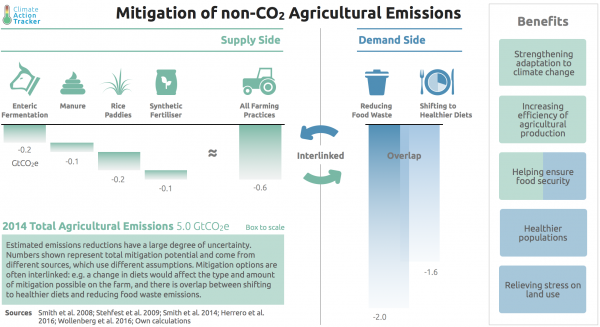A new analysis of agricultural emissions published this week by Climate Action Tracker has pointed out that reducing agricultural emissions through farming practices alone won’t be enough to limit global warming to 1.5°C, but that reducing food waste and changing societies diet could deliver the necessary changes.
 In a new analysis, Climate Action Tracker this week claimed that reducing emissions in the agricultural sector simply by modifying farming practices will not be enough to limit global warming to 1.5°C. Currently, the agricultural sector accounts for approximately 10% of global greenhouse gas emissions, and as much as 50% of non-CO2 emissions, at 5 to 6 GtC02-equivalent per year. As a result, for the agricultural sector to contribute to limiting warming to 2°C, it must reduce non-CO2 agricultural emissions by at least 1 GtCO2e/year — an 11%to 18% reduction by 2030, followed by large reductions thereafter. To limit warming to 1.5°C those emission reductions must be 2.7 GtCO2e/year.
In a new analysis, Climate Action Tracker this week claimed that reducing emissions in the agricultural sector simply by modifying farming practices will not be enough to limit global warming to 1.5°C. Currently, the agricultural sector accounts for approximately 10% of global greenhouse gas emissions, and as much as 50% of non-CO2 emissions, at 5 to 6 GtC02-equivalent per year. As a result, for the agricultural sector to contribute to limiting warming to 2°C, it must reduce non-CO2 agricultural emissions by at least 1 GtCO2e/year — an 11%to 18% reduction by 2030, followed by large reductions thereafter. To limit warming to 1.5°C those emission reductions must be 2.7 GtCO2e/year.
The new analysis briefing published by Climate Action Tracker focuses on other options for reducing non-CO2 emissions in the agricultural sector from two separate angles — key areas “on the field” and trends in consumer behavior. The briefing addressed three main areas of action:
- changing farming practices
- reducing food waste
- changing diets
“Changing farm practices could lead to a reduction of 0.6 GtCO2e/year, but when combined with changing diets away from beef and dairy and reducing food waste, we could achieve a reduction of around 3 GtCO2e/year, possibly enough to decarbonise the sector to a 1.5°C pathway,” said Niklas Höhne of NewClimate Institute. “Further research needs to look at the interactions between these areas, to reduce the uncertainty in total reduction potential.”
One wonders, however, whether concerns surrounding the environment would be enough to change society’s dietary habits, considering that issues of health have not managed to change society’s choices.
The issues are many and vary widely depending on region. The main sources of non-CO2 emissions are methane (CH4) and nitrous oxide (N2O), and in the agricultural sector are focused in enteric fermentation, manure, synthetic fertilizers, rice cultivation, crop residues, and cultivation of organic soils. However, there is not necessarily the same problem in each country or region. Across the European Union, the US, and China, a large share of non-CO2 emissions results from synthetic fertilizer, but in South and East Asia a large share of emissions stem from rice cultivation.
One of the two potential solutions highlighted in the brief, reducing food waste, could have important ramifications. Industrialized nations unsurprisingly have a much higher per-capita food waste carbon footprint than developing nations, but both developing and developed countries can make important changes to their own specific food waste issues.
“Over a third of the food we produce — about 1.3 billion tonnes each year — is wasted,” explained Yvonne Deng of Ecofys, a Navigant company. “If food waste were a country it would be the third largest emitter of greenhouse gases, with an estimated 2011 level of 3.5 GtCO2e/year.”
The second of the two solutions, changing diets, would rely on reducing reliance on beef and dairy use, and could result in an estimated 30% reduction in food-related emissions.
“Dietary shifts could reduce land demand by more than one billion hectares and even bend the emissions curve downwards, something which technical mitigation alone is not expected to do,” said said Claire Fyson from Climate Analytics. “In fact, some governments have already introduced policies to encourage dietary changes because of their public health benefits.”
While changing people’s diet seems like a long shot, one potential idea is to introduce an emissions tax on certain food commodities, but even this seems like an extraordinary long shot.
